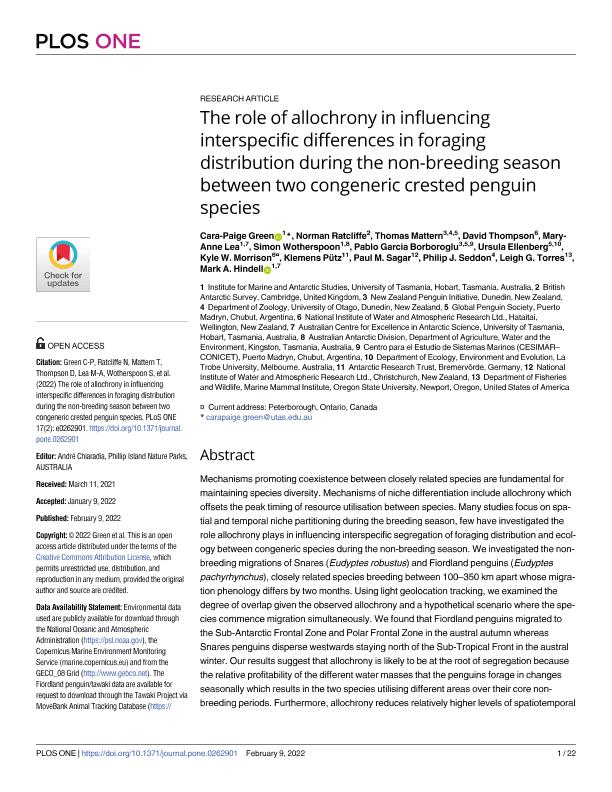Mostrar el registro sencillo del ítem
dc.contributor.author
Green, Cara Paige
dc.contributor.author
Ratcliffe, Norman
dc.contributor.author
Mattern, Thomas
dc.contributor.author
Thompson, David
dc.contributor.author
Lea, Mary Anne
dc.contributor.author
Wotherspoon, Simon
dc.contributor.author
Garcia Borboroglu, Jorge Pablo

dc.contributor.author
Ellenberg, Ursula
dc.contributor.author
Morrison, Kyle W.
dc.contributor.author
Pütz, Klemens
dc.contributor.author
Sagar, Paul M.
dc.contributor.author
Seddon, Philip J.
dc.contributor.author
Torres, Leigh G.
dc.contributor.author
Hindell, Mark A.
dc.date.available
2023-07-25T19:53:13Z
dc.date.issued
2022-02
dc.identifier.citation
Green, Cara Paige; Ratcliffe, Norman; Mattern, Thomas; Thompson, David; Lea, Mary Anne; et al.; The role of allochrony in influencing interspecific differences in foraging distribution during the non-breeding season between two congeneric crested penguin species; Public Library of Science; Plos One; 17; 2; 2-2022; 1-22; e0262901
dc.identifier.issn
1932-6203
dc.identifier.uri
http://hdl.handle.net/11336/205473
dc.description.abstract
Mechanisms promoting coexistence between closely related species are fundamental for maintaining species diversity. Mechanisms of niche differentiation include allochrony which offsets the peak timing of resource utilisation between species. Many studies focus on spatial and temporal niche partitioning during the breeding season, few have investigated the role allochrony plays in influencing interspecific segregation of foraging distribution and ecology between congeneric species during the non-breeding season. We investigated the non-breeding migrations of Snares (Eudyptes robustus) and Fiordland penguins (Eudyptes pachyrhynchus), closely related species breeding between 100–350 km apart whose migration phenology differs by two months. Using light geolocation tracking, we examined the degree of overlap given the observed allochrony and a hypothetical scenario where the species commence migration simultaneously. We found that Fiordland penguins migrated to the Sub-Antarctic Frontal Zone and Polar Frontal Zone in the austral autumn whereas Snares penguins disperse westwards staying north of the Sub-Tropical Front in the austral winter. Our results suggest that allochrony is likely to be at the root of segregation because the relative profitability of the different water masses that the penguins forage in changes seasonally which results in the two species utilising different areas over their core non-breeding periods. Furthermore, allochrony reduces relatively higher levels of spatiotemporal overlap during the departure and arrival periods, when the close proximity of the two species’ colonies would cause the birds to congregate in similar areas, resulting in high interspecific competition just before the breeding season. Available evidence from other studies suggests that the shift in phenology between these species has arisen from adaptive radiation and phenological matching to the seasonality of local resource availability during the breeding season and reduced competitive overlap over the non-breeding season is likely to be an incidental outcome.
dc.format
application/pdf
dc.language.iso
eng
dc.publisher
Public Library of Science

dc.rights
info:eu-repo/semantics/openAccess
dc.rights.uri
https://creativecommons.org/licenses/by/2.5/ar/
dc.subject
PENGUINS
dc.subject
SNARES PENGUINS
dc.subject
FIORDLAND PENGUINS
dc.subject
ALLOCHRONY
dc.subject
NEW ZEALAND
dc.subject
MARINE ECOLOGY
dc.subject.classification
Ecología

dc.subject.classification
Ciencias Biológicas

dc.subject.classification
CIENCIAS NATURALES Y EXACTAS

dc.title
The role of allochrony in influencing interspecific differences in foraging distribution during the non-breeding season between two congeneric crested penguin species
dc.type
info:eu-repo/semantics/article
dc.type
info:ar-repo/semantics/artículo
dc.type
info:eu-repo/semantics/publishedVersion
dc.date.updated
2023-07-10T10:45:08Z
dc.journal.volume
17
dc.journal.number
2
dc.journal.pagination
1-22; e0262901
dc.journal.pais
Estados Unidos

dc.journal.ciudad
San Francisco
dc.conicet.avisoEditorial
This is an open access article distributed under the terms of the Creative Commons Attribution License, which permits unrestricted use, distribution, and reproduction in any medium, provided the original author and source are credited.
dc.description.fil
Fil: Green, Cara Paige. University of Tasmania; Australia
dc.description.fil
Fil: Ratcliffe, Norman. British Antartic Survey; Reino Unido
dc.description.fil
Fil: Mattern, Thomas. Global Penguin Society; Estados Unidos. New Zealand Penguin Initiative; Nueva Zelanda. University of Otago; Nueva Zelanda
dc.description.fil
Fil: Thompson, David. National Institute of Water and Atmospheric Research; Nueva Zelanda
dc.description.fil
Fil: Lea, Mary Anne. University of Tasmania; Australia
dc.description.fil
Fil: Wotherspoon, Simon. University of Tasmania; Australia. Department of Agriculture, Water and the Environment; Australia
dc.description.fil
Fil: Garcia Borboroglu, Jorge Pablo. Global Penguin Society; Argentina. Consejo Nacional de Investigaciones Científicas y Técnicas. Centro Científico Tecnológico Conicet - Centro Nacional Patagónico. Centro para el Estudio de Sistemas Marinos; Argentina. New Zealand Penguin Initiative; Nueva Zelanda
dc.description.fil
Fil: Ellenberg, Ursula. Global Penguin Society; Argentina. La Trobe University; Australia
dc.description.fil
Fil: Morrison, Kyle W.. National Institute of Water and Atmospheric Research; Nueva Zelanda
dc.description.fil
Fil: Pütz, Klemens. Antarctic Research Trust; Alemania
dc.description.fil
Fil: Sagar, Paul M.. National Institute of Water and Atmospheric Research; Nueva Zelanda
dc.description.fil
Fil: Seddon, Philip J.. University Of Otago; Canadá
dc.description.fil
Fil: Torres, Leigh G.. State University of Oregon; Estados Unidos
dc.description.fil
Fil: Hindell, Mark A.. University of Tasmania; Australia
dc.journal.title
Plos One

dc.relation.alternativeid
info:eu-repo/semantics/altIdentifier/doi/http://dx.doi.org/10.1371/journal.pone.0262901
dc.relation.alternativeid
info:eu-repo/semantics/altIdentifier/url/https://dx.plos.org/10.1371/journal.pone.0262901
Archivos asociados
